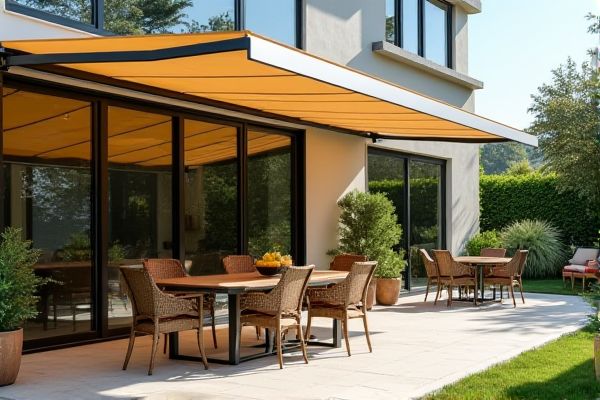
Retractable awnings offer versatile shade control with the ability to extend or retract as needed, providing convenience and adaptability for changing weather conditions, while fixed canopies deliver permanent, sturdy shelter without adjustment options. Explore the rest of the article to discover which option best suits Your outdoor living space and lifestyle.
Table of Comparison
| Feature | Retractable Awning | Fixed Canopy |
|---|---|---|
| Flexibility | Adjustable: extends or retracts as needed | Permanent: fixed structure, no adjustment |
| Installation | Wall-mounted, easier installation | Requires sturdy support, complex installation |
| Durability | Less durable, prone to wear from weather | Highly durable, designed for long-term use |
| Cost | Typically lower initial cost | Higher upfront investment |
| Maintenance | Requires regular maintenance to ensure mechanism works | Minimal maintenance needed |
| Weather Protection | Good shade, limited protection in heavy rain or wind | Provides consistent protection from sun, rain, and wind |
| Space Impact | Retracts to save space when not in use | Occupies permanent space |
Introduction: Retractable Awnings vs Fixed Canopies
Retractable awnings offer versatile shade solutions with adjustable coverage, allowing users to extend or retract the fabric based on weather conditions and sun exposure. Fixed canopies provide permanent, durable shelter ideal for consistent protection from rain and sun but lack the flexibility of movement. Selecting between retractable awnings and fixed canopies depends on factors such as space requirements, weather variability, and desired functionality for outdoor areas.
Defining Retractable Awnings
Retractable awnings are adjustable outdoor coverings made from durable fabric stretched over a metal frame, allowing you to extend or retract them as needed to control sunlight and weather exposure. Unlike fixed canopies, which provide permanent shade structures, retractable awnings offer flexibility and customization for your outdoor living spaces. Their versatility enhances energy efficiency by reducing indoor heat gain, making them a smart choice for adaptable shading solutions.
What Is a Fixed Canopy?
A fixed canopy is a permanent outdoor structure designed to provide shade and protection from the elements, typically attached to a building or free-standing with sturdy posts. Unlike retractable awnings, fixed canopies are constructed with durable materials such as metal, polycarbonate, or fabric stretched over a rigid frame, offering long-lasting coverage without the option to retract or adjust. This makes fixed canopies ideal for consistent and robust shelter in commercial spaces, patios, and gardens.
Comparing Installation Requirements
Retractable awnings typically require a sturdy wall or fascia for mounting and professional installation to ensure proper alignment and secure operation, with electrical wiring needed for motorized models. Fixed canopies, often supported by posts or integrated into building structures, demand a more permanent foundation, such as concrete footings, increasing installation complexity and time. Understanding your space and structural support is essential for selecting the right option to suit your installation capabilities and long-term maintenance preferences.
Durability and Maintenance
Retractable awnings offer adjustable protection but typically require more frequent maintenance due to moving parts that can wear out over time, such as motors or manual cranks. Fixed canopies provide superior durability with sturdy, permanent structures designed to withstand harsh weather without regular upkeep, making them ideal for long-term protection. Choosing between the two depends on your preference for flexibility versus minimal maintenance and lasting strength.
Flexibility and Adjustability
Retractable awnings offer superior flexibility and adjustability by allowing you to extend or retract the fabric based on weather conditions or desired shade levels, providing customizable outdoor comfort. Fixed canopies provide consistent, permanent coverage but lack the ability to adapt to changing sunlight or weather, limiting their versatility. Choosing a retractable awning maximizes control over your outdoor environment, enhancing usability throughout the day and seasons.
Aesthetic Appeal and Design Options
Retractable awnings offer versatile aesthetic appeal with customizable fabrics, colors, and patterns, allowing homeowners to adapt their outdoor space design according to seasonal changes or personal preferences. Fixed canopies provide a permanent architectural element that enhances structural presence and can be tailored with materials like metal, wood, or polycarbonate to match the building's style. Both options elevate curb appeal, but retractable awnings deliver dynamic design flexibility, while fixed canopies emphasize long-term, integrated visual impact.
Weather Protection and Performance
Retractable awnings offer versatile weather protection by extending to shield against sun, rain, and light wind, then retracting to prevent damage during severe weather. Fixed canopies provide consistent, durable coverage with robust materials designed to withstand heavy rain, snow, and strong winds without the need for adjustment. Both systems enhance outdoor comfort, but retractable awnings excel in adaptability while fixed canopies prioritize long-term, reliable shelter.
Cost Considerations and Value
Retractable awnings typically have higher upfront costs due to mechanical components and installation but offer long-term value through adjustable shading and energy savings. Fixed canopies generally cost less initially but lack flexibility, potentially leading to higher cooling expenses during hot months. Your choice should weigh initial investment against ongoing energy efficiency and the adaptability of sun protection.
Which Shade Solution Is Right for You?
Retractable awnings offer customizable shade and protection, allowing you to extend or retract the canopy based on weather conditions, making them ideal for versatile outdoor spaces. Fixed canopies provide permanent, sturdy shelter that requires minimal maintenance and suits areas needing consistent coverage. Your choice depends on whether you prioritize flexibility and control or durable, constant shade for your outdoor living areas.
 homyna.com
homyna.com